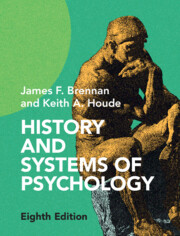Refine search
Actions for selected content:
36831 results in Cambridge Textbooks

The Study of Language
-
- Published online:
- 09 November 2022
- Print publication:
- 10 November 2022
-
- Textbook
- Export citation

History and Systems of Psychology
-
- Published online:
- 04 November 2022
- Print publication:
- 17 November 2022
-
- Textbook
- Export citation
Chapter 9 - The Identity and Person of Jesus Christ
- from Part II - Key Themes of Christian Theology
-
- Book:
- An Introduction to Christian Theology
- Published online:
- 18 October 2022
- Print publication:
- 03 November 2022, pp 255-287
-
- Chapter
- Export citation
Chapter 13 - The Church and Its Mission
- from Part II - Key Themes of Christian Theology
-
- Book:
- An Introduction to Christian Theology
- Published online:
- 18 October 2022
- Print publication:
- 03 November 2022, pp 371-399
-
- Chapter
- Export citation
11 - Information-Theoretic Inference and Learning
- from Part III - Advanced Tools and Algorithms
-
- Book:
- Machine Learning for Engineers
- Published online:
- 25 January 2023
- Print publication:
- 03 November 2022, pp 419-450
-
- Chapter
- Export citation
Copyright page
-
- Book:
- Machine Learning for Engineers
- Published online:
- 25 January 2023
- Print publication:
- 03 November 2022, pp iv-iv
-
- Chapter
- Export citation
8 - Statistical Learning Theory
- from Part III - Advanced Tools and Algorithms
-
- Book:
- Machine Learning for Engineers
- Published online:
- 25 January 2023
- Print publication:
- 03 November 2022, pp 311-331
-
- Chapter
- Export citation
Copyright page
-
- Book:
- Winds of Hope, Storms of Discord
- Published online:
- 21 October 2022
- Print publication:
- 03 November 2022, pp iv-iv
-
- Chapter
- Export citation
3 - Inference, or Model-Driven Prediction
- from Part II - Fundamental Concepts and Algorithms
-
- Book:
- Machine Learning for Engineers
- Published online:
- 25 January 2023
- Print publication:
- 03 November 2022, pp 53-93
-
- Chapter
- Export citation
2 - We May Not Now Relax Our Guard
-
- Book:
- Winds of Hope, Storms of Discord
- Published online:
- 21 October 2022
- Print publication:
- 03 November 2022, pp 45-71
-
- Chapter
- Export citation
Chapter 7 - Humanity in the Image of God and the Disfigurement of Sin
- from Part II - Key Themes of Christian Theology
-
- Book:
- An Introduction to Christian Theology
- Published online:
- 18 October 2022
- Print publication:
- 03 November 2022, pp 201-227
-
- Chapter
- Export citation
6 - Berkeley Cong
-
- Book:
- Winds of Hope, Storms of Discord
- Published online:
- 21 October 2022
- Print publication:
- 03 November 2022, pp 165-195
-
- Chapter
- Export citation
12 - Bayesian Learning
- from Part III - Advanced Tools and Algorithms
-
- Book:
- Machine Learning for Engineers
- Published online:
- 25 January 2023
- Print publication:
- 03 November 2022, pp 451-500
-
- Chapter
- Export citation
Preface
-
- Book:
- Machine Learning for Engineers
- Published online:
- 25 January 2023
- Print publication:
- 03 November 2022, pp xi-xvi
-
- Chapter
- Export citation
Chapter 4 - A Tale of Two Theisms
- from Part II - Key Themes of Christian Theology
-
- Book:
- An Introduction to Christian Theology
- Published online:
- 18 October 2022
- Print publication:
- 03 November 2022, pp 86-121
-
- Chapter
- Export citation
4 - Supervised Learning: Getting Started
- from Part II - Fundamental Concepts and Algorithms
-
- Book:
- Machine Learning for Engineers
- Published online:
- 25 January 2023
- Print publication:
- 03 November 2022, pp 94-135
-
- Chapter
- Export citation
2 - Background
- from Part I - Introduction and Background
-
- Book:
- Machine Learning for Engineers
- Published online:
- 25 January 2023
- Print publication:
- 03 November 2022, pp 14-50
-
- Chapter
- Export citation
5 - Optimization for Machine Learning
- from Part II - Fundamental Concepts and Algorithms
-
- Book:
- Machine Learning for Engineers
- Published online:
- 25 January 2023
- Print publication:
- 03 November 2022, pp 136-193
-
- Chapter
- Export citation
10 - The Picture Always Overrides
-
- Book:
- Winds of Hope, Storms of Discord
- Published online:
- 21 October 2022
- Print publication:
- 03 November 2022, pp 290-320
-
- Chapter
- Export citation
Maps
-
- Book:
- Winds of Hope, Storms of Discord
- Published online:
- 21 October 2022
- Print publication:
- 03 November 2022, pp xii-xii
-
- Chapter
- Export citation
